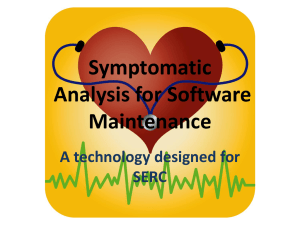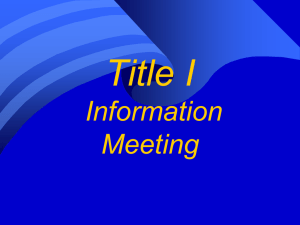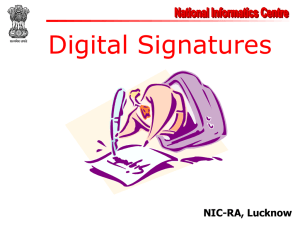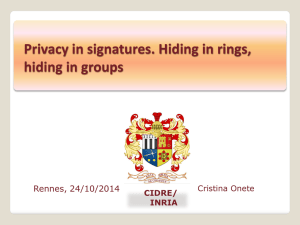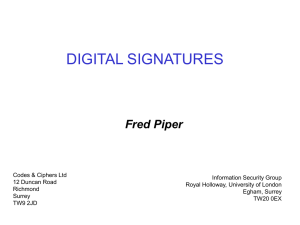Legal Foundation for Electronic Signatures in Court
advertisement
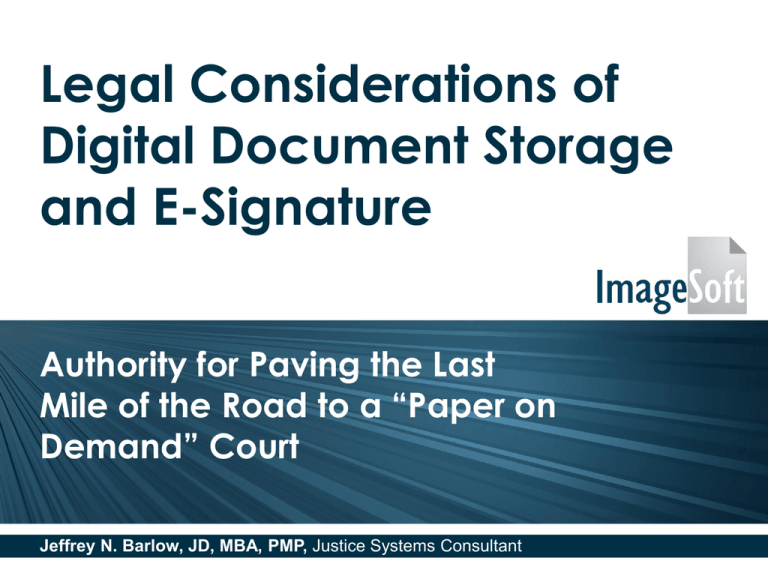
Legal Considerations of Digital Document Storage and E-Signature Authority for Paving the Last Mile of the Road to a “Paper on Demand” Court Jeffrey N. Barlow, JD, MBA, PMP, Justice Systems Consultant Bonus: Cost Savings • E-Signatures reduce the cost of capturing a signature – Judges can sign more rapidly – Signature can be collected from many locations • Paper reductions and associated costs • E-Signature is often the last mile to a fully paper-on-demand court. POD will provide: – Dramatic staff cost reductions – Process automation (workflow) – Public access to and sale of records Related Topics • • • • • • • • • • “Official” document Retention requirements Confidentiality Privacy Delivery Security Access Migration planning Conversion of legacy documents E-Filing Session Agenda Moving Beyond Wet Signatures and Raised Seals in Court Operations • Is it Legal? • Is it Safe? • Is it Proven? Is It Legal? Legal Foundation for Electronic Signatures • “…[I]t is arguable that an electronic signature qualifies as a signature without any legislative assistance.” John Gregory article • Almost all jurisdictions have enacted legislation anyway – To create certainty of acceptance – Symbolic importance of signatures What Is A Signature? •“Too Few Definitions” (Professor Chris Reed) •Anything that the signatory intends to have act as binding him or herself to the contents. •At Common Law, no particular form required Primary Purpose • Establish the Identity of the Signatory • Establish the Signatory’s Intention to make a signature • Establish that the Signatory Adopts the Contents Secondary Purpose • Validate official action • Protect consumers Tertiary Purpose • Provide Solemnity through the Ceremony of signing What Is An Electronic Signature? “Electronic signature" means an electronic sound, symbol, or process attached to or logically associated with a document and executed or adopted by a person with the intent to sign the document. From the Model Laws and their derivatives Jurisdictional Overview • • • • International European Union Canada United States – Federal/National – States International • UNCITRAL – Model Law on Electronic Commerce (MLEC) – Model Law on Electronic Signatures (MLES) • European Union Directive: Advanced Electronic Signatures • Canada – Uniform Electronic Commerce Act – Personal Information Protection and Electronic Documents Act (2000, c. 5) – Secure Electronic Signature Regulations (SOR/200530) (Enabling Statute: Canada Evidence Act (R.S., 1985, c. C-5)) US Federal/National • Legislation – Uniform Electronic Transactions Act (UETA) – Electronic Signatures in Global and National Commerce (E-SIGN) Act • Standards – Department of Defense 5015.2 Standard – FIPS Publication 1863, Specifications for the Digital Signature Standards • American Bar Association Digital Signature Guidelines Michigan • MCL 450.831-450.849 (UETA) • MCL 55.287 (Notaries Public) • MCL 565.232 (Official Seals) • Records Reproduction Act • S Ct Administrative Orders – 2007-24: Adopts many federal rules regarding retention of electrically stored information – Series of orders permitting pilot programs • Michigan Court Rules Chapter 8: Michigan Courts Records and Information Management Manual Oregon • • • • • • • • • ORS Chapter 84 (UETA) ORS 184.473-477 – Information Technology Mgmt ORS 1.002 – Chief Justice Authority to Make Rules Regarding Electronic Documents ORS Chapter 192 – Records OAR 125-600 – Identity Authentication/Electronic Signatures Chief Justice Orders UTCR 21 – Filing and Service By Electronic Means Oregon Judicial Dept. Record Retention Rules Oregon Community of Practice – Guidelines for Managing Electronic Records Levels of Authority • • • • • • • • Statutes Case Law Regulations/Administrative Rules Agency/Court Rules General Orders Agency/Court Policies Agency/Court Procedures Audit Processes How to Establish the Legal Foundation • Start at the top (Constitution, Statutes) and work down • Look for disconnects between levels • For the level at which the disconnect occurs – Determine what the disconnect is – Determine who should decide what changes to the level should be – Determine what effect making the required change would have on the lower levels Legal Authorities - Summary • E-Signatures are legal and enforceable, even In the absence of statutory authority • Legislation, rules, and practices surrounding use of esignatures are uniformly intended to facilitate and insure the efficacy of e-signatures • The Model Laws have been so widely adopted, and in use for so long, that the issue of acceptability is rarely (maybe never)raised • Statutory clarifications, rules, court orders, etc. are often promulgated, even where their main purpose is to provide additional comfort level rather to overcome any explicit restrictions Is It Safe? Records Management – Basic Principles To Be Considered Trustworthy, a Government Record Must – Be Authentic – Be Reliable – Have Integrity – Be Usable MCL 24.402 (Michigan Records Reproduction Act) Characteristics of Record Authenticity An Authentic Record Can Be Proven • To be what it professes to be; • To have been created or sent by the person claiming to have sent it; and • To have been created or sent at that time Best Practices for Reproducing Public Records, State of Michigan Records Management Services Characteristics of Record Reliability A Reliable Record Is One • Whose contents can be trusted to be a full and accurate representation of the transactions, activities, or facts to which it attests; and • Which can be depended upon in the course of subsequent transactions or activities. Best Practices for Reproducing Public Records, State of Michigan Records Management Services Characteristics of Record Integrity A Record Has Integrity If It Is • Complete; and • Unaltered Best Practices for Reproducing Public Records, State of Michigan Records Management Services Characteristics of Record Usability A Record Is Usable If It Can Be • • • • Located; Retrieved; Presented; and Interpreted Best Practices for Reproducing Public Records, State of Michigan Records Management Services Advanced or Digital Electronic Signature • Uniquely linked to the signatory • Capable of identifying the signatory • Created using means that the signatory can maintain under his or her sole control • Linked to the content in such a manner that any subsequent change of the data is detectable (EU Directive; E-SIGN) Security • Environment • Technology • Policies and Procedures • Operational Responsibility • Audit Signature Security Something you know (Password) Something you have (Token) Something about you (Biometric) Something about where you are (Computer) • Someone you know (Trusted Guardian) • Combination • • • • Technologies Main Types • Password – Something you know • Keypad – A signing captured electronically • Digitally Captured – Handwritten signatures digitized through the writing process • Public Key Infrastructure – Dealing with a trusted third party • Hash Functions – Using information that, because of the way it is generated, cannot be duplicated or falsified • Tokens – A physical object • Cryptographic - Application of an algorithm • Biometric – A personal physical characteristic • Combinations – Use of two or more methods How Someone Can Falsify Your Signature • Someone has access to your PC; AND • Knows your password; AND • If you are using a signature pad, can forge your signature; and • If you have a physical token, has your token; AND • Knows how to operate the system; AND • Can control the Workflow so that no one else becomes suspicious; AND • Can make sure you do not find out about it Is It Proven? Sampling of Courts Using Judicial Electronic Signatures • Oregon Circuit Courts • Maricopa County, Arizona (Phoenix) • King County Superior Court, Washington (Seattle) • Michigan: Washtenaw, Genesee, Ottawa, Grand Traverse, Tuscola, and St Clair Counties • Ohio Conclusion Moving Beyond Wet Signatures on Paper • It Is Legal! • It Is Safe! • It Is Proven! About Jeffrey Barlow Jeffrey Barlow has spent over 35 years working with courts, both as an attorney and as an information systems professional. After practicing law for ten years in the private and public sectors, he earned a second bachelor’s degree in computer science and joined the State of Oregon court system’s newly formed Information Systems Division in 1986. Over the next 20 years, Jeff participated in and led major court technology development and implementation projects as a Systems Analyst, Business Analyst, Project Manager, Project Office Manager, and Deputy CIO. He also holds an MBA and is certified by the Project Management Institute as a Project Management Professional (PMP). He now works as a Justice Systems Consultant with ImageSoft, Inc. About ImageSoft, Inc. ImageSoft, Inc., was founded in 1996 and provides technology solutions to automate, streamline and improve workplace processes, increase productivity, reduce operating costs, and save time and money. Based in Southfield, Mich., with offices in Raleigh, N.C., and Portland, Ore., the company serves customers throughout the U.S., Canada and Mexico. Its markets include insurance companies, government, the courts, healthcare and educational institutions, and manufacturers. An award-winning company, since 2008 ImageSoft has consistently been named one of the nation’s Fastest-Growing Privately Held Companies by Inc. Magazine, and is repeatedly selected as one of Michigan’s Economic Bright Spots and as one of Metropolitan Detroit’s 101 Best and Brightest Companies to Work For. Additionally, in 2008 the Edward Lowe Foundation cited ImageSoft as a Michigan 50 Companies to Watch. For more information visit www.imagesoftinc.com Thank You! Presentation Materials May Be Accessed At http://www.imagesoftinc.com/resources.html

